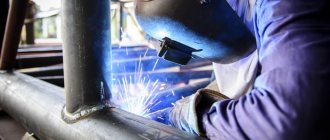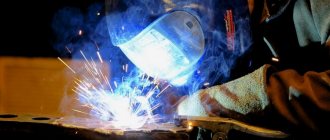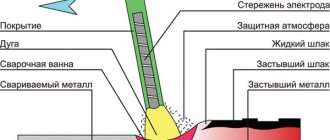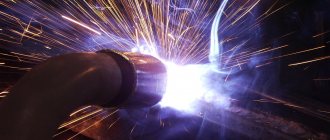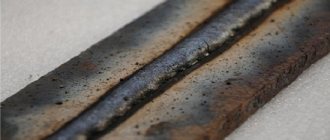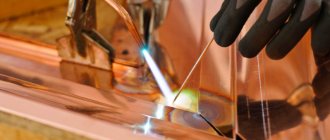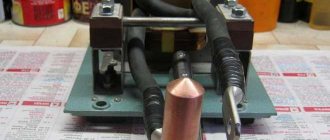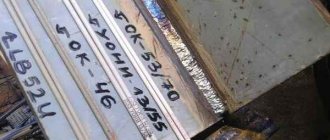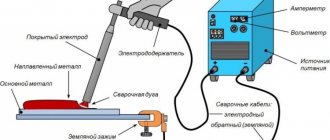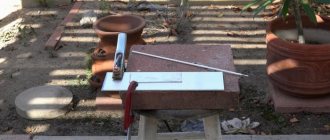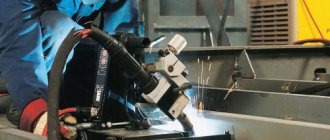Production of MP-3 electrodes
The production of MP-3 brand electrodes is regulated by the requirements and provisions of GOST 9466 and 9467 . In accordance with them, this filler material belongs to type E46; electrodes of this type are used in welding structural low-alloy carbon steels with a carbon content of at least 0.25%. The coating of the MP-3 electrode is rutile. The metal core is coated in powder form with a concentrate of rutile, a mineral that consists primarily of titanium dioxide (TiO2). The composition of the coating may include carbonate or aluminosilicate - they increase the viscosity of the deposited metal, reducing the risk of pores and cracks in the resulting weld.
The material from which the core of the MP-3 electrode is made is cold-rolled wire Sv08 made of low-carbon steel with a diameter of 2 to 6 mm. These electrodes can be used to weld parts with a thickness of 3 to 20 mm. The indicator of welded steels in terms of temporary mechanical tensile strength is up to 490 MPa.
Decent analogues in comparison
In addition to MP-3 electrodes, modifications such as ANO and UONI are popular among welders. They are often compared with each other to choose the best option, but this is not entirely correct. These rods differ not only in coating, but also in structure. The main difference lies in the composition and method of coating.
SSSI electrodes
Unlike the MP-3 brand, UONI rods have a base coating rather than rutile. They are designed to operate from DC devices with reverse polarity. Before welding the SSSI, the surface must be thoroughly cleaned. Spraying is also sensitive to moisture.
Brief characteristics of this brand:
- surfacing coefficient – 9.5 g/Ah;
- consumption per 1 kg of metal – 1.7 kg;
- productivity – 1.4 kg/h;
- safety margin – 540 MPa;
- fluidity – up to 420 MPa;
- relative elongation – up to 22%.
ANO electrodes
ANO rods are distinguished by the variety of rods and specific parameters. It is inappropriate to compare them directly with the MP-3 brand. This is due to the fact that these elements are designed for welding metal up to 4 mm and are not suitable where MR modifications are needed.
Short description:
| Diameter, mm | Length, mm | Package capacity 1 kg (pcs.) | Limit operating current, A |
| 2,0 | 300 | 95 | 100 |
| 3,0 | 350 | 40 | 140 |
| 4,0 | 350 | 40 | 180 |
Symbol of MP 3 electrodes - example of a complete decoding
- E - electrodes for manual arc welding;
- 46 — temporary tensile strength — no more than 46 kgf/mm2;
- MP-3 - brand;
- LUX is the commercial name under which the electrode is produced by a certain manufacturer;
- Ø—diameter;
- U - for welding carbon and low-alloy steels;
- D - with a thick coating;
- 43 - temporary tensile strength in the state after welding at normal temperature;
- 0 — relative elongation less than 18%;
- ->(3) - impact strength of the deposited metal αН45 (at a temperature of - 20°C), not less than 3.5 kgf•m/cm2;
- RC - rutile-cellulose coating;
- 11 - welding in all spatial positions except vertical from top to bottom with alternating and direct current.
Features and operating instructions for MP-3
You can cook with the indicated electrodes on direct and alternating current. Generators or inverters must produce a voltage of at least 50 V at idle. At direct current, work is carried out with reverse polarity (plus to the holder). MP-3 configuration elements can be used in any spatial position.
Manufacturers indicate in the instructions that the rules for storing electrodes must be followed.
The products are placed in a dry, heated room with an air temperature of at least +15.
The product must be protected from direct moisture and mechanical impact.
MR electrodes - 3 technical characteristics
MP-3 electrodes are used for welding with direct (reverse polarity) or alternating current, which provides an open-circuit voltage of at least 50 Volts. Under normal temperature conditions, the metal of the resulting compound exhibits the following characteristics:
- The mechanical tensile strength indicator is no more than 46 kgf/mm2;
- Relative extension — 18%;
- Impact strength - 8 kgf∙m/cm2.
- The consumption of MP-3 electrodes per 1 kg of metal is about 1.7 kg of MP-3.
- The weld deposition rate limit is 8.5 g/A*h.
- Metal spatter coefficient during welding — 9-13%;
- Open circuit voltage - 60-80 V.
- Welding in all spatial positions, except vertical from top to bottom.
To calculate the correct operating current for welding, it is necessary to take into account the diameter of the electrode and the spatial position in which the welding is performed. The table shows the recommended parameters.
| Diameter | Position | Current strength |
| 3 mm | vertical | 90−110 A |
| lower | 100−140 A | |
| ceiling | 100−120 A | |
| 4 mm | vertical | 140−180 A |
| lower | 160−220 A | |
| ceiling | 140−180 A | |
| 5 mm | vertical | 160−200 A |
| lower | 180−260 A | |
| 6 mm | only the bottom | 300−360 A |
Characteristics and properties
The technical parameters of the electrodes include the consumption for surfacing a given amount of metal (weld). To process 1 kg of material, 1.7 kg of MP-3 type rods will be required. As a result, a productivity of 1.7 kg/h is ensured, and the operating coefficient is 8.5 g/Ah.
These electrodes are characterized by high operating speed and allow welding with full contact with the surface or with a short arc at a distance. Products of the LEZ MR type are produced on Losiny Ostrov, in the Moscow region, Kostroma region, and Syzran. The closest analogues of foreign production are manufactured in Cleveland (USA).
Weight and diameter
The setting of the welding current and the spatial position of the seam being formed depend on the size of the electrode. The indicators are as follows:
| Diameter, mm | Vertical seam, A | Bottom seam, A | Ceiling seam, A |
| 3,0 | Up to 110 | 100-140 | Up to 120 |
| 4,0 | 150-180 | Up to 220 | 140-180 |
| 5,0 | Up to 200 | Up to 260 | |
| 6,0 | 300-360 |
The weight of the MP-3 electrode and its length also depend on the diameter. Parameters vary from 30 to 92 g and from 350 to 450 mm, respectively.
Surfacing composition
Welding is carried out using the tear-off weld method, lighting an arc at the left edge, carrying out wiring from left to right, then in the opposite direction. The operation must be performed quickly so that the seam does not have time to cool. The process produces a lot of slag, which completely fills the bath and the gap across its entire width. The temperature of the coating is significantly higher than that of the steel being processed.
The material is easily separated after cooling during multi-pass wiring.
The spattering of the metal is weak, the slag lays down in a neat, even layer and peels off easily. When working with titanium dioxide, the residues fall into the melting bath, forming specific shells. Surfacing in mass fractions consists of:
- manganese (0.08-0.12);
- silicon (0.07-0.2);
- carbon (up to 0.8);
- phosphorus (up to 0.04);
- sulfur (up to 0.04).
We recommend reading General characteristics and design features of surfacing electrodes type T590
Mechanical properties of the seam
The difference between the use of MP-3 electrodes and analogues is the possibility of welding uncleaned edges of workpieces. Oxides, scale, dust, moisture do not deteriorate the quality of the seam. During operation, contaminants evaporate and mix with the slag. This results in a seam with good technological parameters:
- impact viscosity – up to 8 kgf/sq.cm;
- breaking resistance – about 46 kgf/sq.mm;
- elongation rate – up to 20%.
Quantity per pack
Manufacturers package the electrodes in question in packs weighing 1.0/2.5/5.0 kg. The length and weight of the rod depend on the diameter of the elements, as well as their number in the package. The table provides information on the capacity of electrodes in a 1-kg pack, taking into account the specified parameters.
| Diameter, mm | Weight, g | Rod length, mm | Package quantity, 1.0 kg (pcs.) |
| 3,0 | 32,0 | 350 | 39,0 |
| 4,0 | 62,0 | 450 | 16,0 |
| 5,0 | 92,0 | 450 | 11,0 |
Voltage and device settings
The characteristics of MP-3 electrodes involve connecting reverse polarity if work is carried out on direct current. With alternating voltage, the polarity of the connection does not matter. You can cook with a short, long or intermittent arc. Damp rods are calcined for 45-60 minutes at a temperature of 180 °C. The current is selected taking into account the diameter of the element. For products with a cross section of 3 mm, 140 A is enough; modifications with a thickness of 5-6 mm are used with a current strength of 300 A. Work is performed by holding the rod at an angle of 45°.
Flaws
- The connection obtained by welding is characterized by high strength.
- The arc is distinguished by easy ignition and combustion stability, especially at low current strength.
- Re-ignition is achieved without difficulty.
- The resulting seam has no joints, it is even and has a good presentation.
- There are no pronounced transition zones between the weld metal and the part.
- Thanks to the rutile type of coating, the seam is reliably protected from slag and oxidation.
- The electrode is characterized by very little metal spattering.
- The work is characterized by high productivity.
- MP-3 is equally suitable for both welding and tack welding.
- Relatively high price - the cost of this consumable is slightly higher than many other electrodes.
- The impossibility of welding vertically from top to bottom - however, many other brands cannot “boast” of this.
- Not the lowest material consumption - 1.7 kg per 1 kg of seam (MR-3R has slightly less - 1.62 kg).
- During the welding process, the electrode must be held at an acute angle relative to the surface being made. If you weld at a right angle, a large amount of slag will inevitably be released, which will penetrate into the seam.
- It is extremely important to set the required current strength - otherwise there is a risk of pores forming in the weld metal.
And one more feature - intermittent sutures must be applied quickly enough, which requires certain skills. However, even beginners can master this technique in a short time, without much experience or special education.
Advantages and disadvantages
The advantages of MP-3 electrodes include:
- rapid formation of a stable arc;
- smooth, reliable seam;
- high connection strength;
- safety, no release of harmful substances;
- easy removal of slag;
- small range of metal spattering;
- high productivity;
- ease of operation.
We recommend reading: How to use OK 46 electrodes
Disadvantages include high price and intensive consumption of welding material.
Application of MP 3 electrodes
Electrodes are widely used in the installation of critical structures made of low-alloy steels, when increased strength of connections is required. Areas of use:
- welding pipes during pipeline installation, creating non-rotating pipe joints;
- welding, repair of tanks operated under high pressure conditions;
- shipbuilding;
- mechanical engineering.
Application area
Welding electrodes of this brand are widely used in areas where low-alloy steels can be found. This includes the creation of metal structures, repair and installation of pipelines, including large thicknesses for large-scale highways. They are used to repair tanks and high-pressure vessels. Thanks to the stable arc, the welding process is practically not affected by external factors. High reliability allows the use of this brand in the field of shipbuilding and mechanical engineering and in other places where high connection responsibility is required. Due to their versatility, electrodes are used wherever low-alloy steels are involved.
Welding electrodes MP-3S with a diameter of 3 mm
Basics of electric welding
An electric current is supplied to the electrode and the part being welded. When the workpiece being welded comes into contact, welding current is transmitted. Due to the fact that the welding arc has up to 7 thousand degrees, the edges on the part being welded melt, forming a welding “pool”. The electrode melts together with the edges , and its coating protects it from environmental influences. At the site of the weld, slag is formed, which also protects against the effects of external defects. Dampness, moisture, air - all this can have a bad effect on the welding seam.
The main component when welding is the welding machine. There are many types, from manual to automatic. Some of them run on electricity, others on gas. The most commonly used devices are for the following types of welding:
- Manual arc.
- Semi-automatic.
- Automatic.
- Argonova.
Manual arc welding is the first and most common type. It is used not only in production and construction, but also in everyday life. This type is easy to use and does not require special environmental conditions. When using a hand-held device, special electrodes are used. They are selected according to the part being manufactured. The parts to be welded can vary from 2 mm to 20 mm or more. However, it is worth remembering to remove the edges for penetration.
Semi-automatic welding is more often used when joining thin metals. However, in production where thick metals are welded, such welding does occur. It is worth considering that in this form a special welding wire is used.
Automatic devices are used in industrial areas. More often, these can be factories and other enterprises engaged in the constant production of identical structures.
Argon welding is performed with gas. When working with such a device, a special wire is used, which is melted using a gas burner.
Useful videos, tests and comparisons
Comparison, differences from other brands
MP-3 electrodes are in great demand among performers. UONI (UONII) and ANO are also popular among craftsmen. These brands are often compared, trying to determine the best option.
SSNI (USNI)
The main differences between MP-3 coated rods and UONI electrodes are presented in the table.
Important ! Comparing MP-3 with UONII rods is not so easy, since individual brands have different characteristics. They belong to different types.
| Electrode brand | MR-3 | UONI-13/55 |
| Electrode coating | Rutile | Basics |
| Type and polarity of current | AC and DC reverse polarity | Direct current reverse polarity |
| Welding conditions | It is possible to perform welding on uncleaned surfaces in wet conditions | Cleaning is a must as the coating is sensitive to moisture |
ANO
The differences between MP-3 electrodes and ANO brand rods are difficult to present in an orderly form. This is due to the variety of ANO rods, as well as their differences and specific characteristics. Let's just say that ANO-4 and ANO-21 will be approximately similar in operation to MP-3.
Thus, each type of electrode is individual and should be used to perform specific work. You need to select rods based on the tasks of the performer.
Video
Unpacking, review of MP-3 (Resanta), testing and comparison with ANO-3 (SZSM)
Varieties
There are several types of electrodes of this brand. This sometimes leads to a dead end when faced with a choice. Therefore, it is necessary, for example, to understand how the MP-3 electrodes differ from the MP-ZS. These species have a lot in common with each other. Their composition and main characteristics are identical. However, there is one feature that answers the difference between the MP-3 and MP-ZS electrodes.
Consumables of the MP 3C brand contain additives, due to the presence of which the arc is ignited more easily and the stability of its combustion increases. They can be used when using a low-power welding inverter. During the welding process, less manganese is released, the seams are more uniform, and their formation is easier.
The MP 3C brand has proven itself well in household use. But MP 3 electrodes can be called more universal. They are used both in everyday life and in industrial work.
